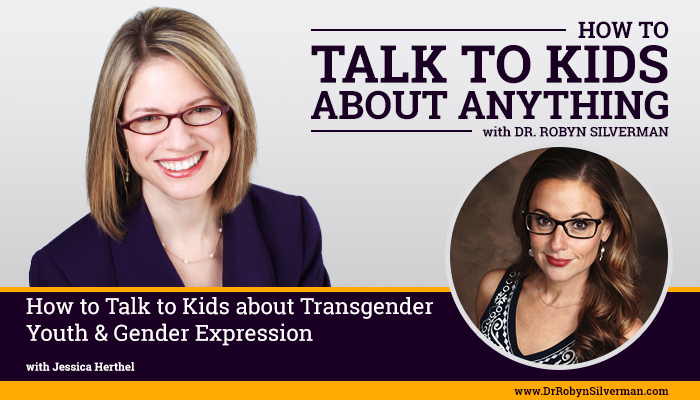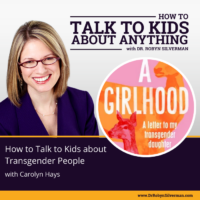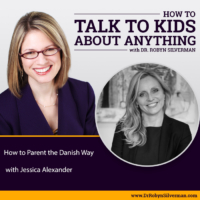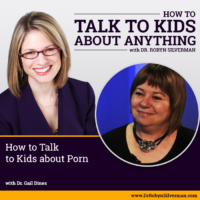Podcast: Play in new window | Download
Subscribe: Apple Podcasts | RSS | More
How to Talk to Kids about Transgender Youth
This podcast is aimed to help parents and educators understand how to knowledgably and compassionately talk about transgender youth and gender expression with children. Especially when many people have their own preconceived notions about gender, it can be hard to speak about the spectrum of gender expression in a non-biased and open-minded way. How do we answer questions about what transgender means? How do we better understand the challenges of transgender and other LGBTQ youth? How can we best support children in our community who are gender non-conforming? This podcast episode with Jessica Herthel, LGBTQ advocate, helps to answer these (and more) questions!
Special Guest: Jessica Herthel
Jessica Herthel is a former attorney, the mother of 3 daughters, and the co-author of the children’s book, “I Am Jazz,” about real-life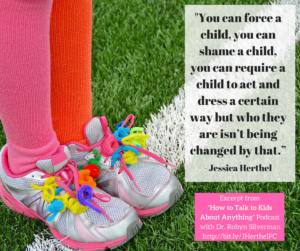 transgender teen Jazz Jennings. Prior to writing the book, Jessica held the position of Education Director at the Stonewall National Museum and Archives in Fort Lauderdale, and has assisted the Broward County Public School District in creating inclusive curriculum and school board policy. Presently Jessica travels around the country presenting “I Am Jazz” to schools and communities, and consults privately with families working to increase support their own LGBTQ kids. JessicaHerthel.com
transgender teen Jazz Jennings. Prior to writing the book, Jessica held the position of Education Director at the Stonewall National Museum and Archives in Fort Lauderdale, and has assisted the Broward County Public School District in creating inclusive curriculum and school board policy. Presently Jessica travels around the country presenting “I Am Jazz” to schools and communities, and consults privately with families working to increase support their own LGBTQ kids. JessicaHerthel.com
Transgender children, gender nonconformity and transgender rights have exploded into our national consciousness. We have become more and more familiar with gender non-binary and transgender people as the media has introduced us to Jazz Jennings, Caitlyn Jenner and Laverne Cox. While the conversation about transgender people has progressed, many parents and educators are still unsure how to talk about transgender issues intelligently and compassionately and there is no time like the present to get the information we need. It is no secret that transgender youth are still suffering from constant scrutiny, bullying, humiliation and misunderstanding. And that is why I feel so blessed to have my friend and colleague, Jessica Herthel, on the show today.
The podcast provides:
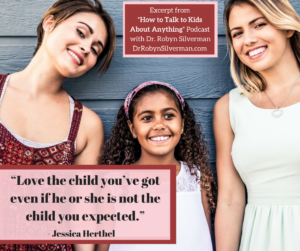 Tips: How to help better understand transgender, discuss transgender, help transgender youth, help kids to show kindness to young people who are in the LGBTQ community?
Tips: How to help better understand transgender, discuss transgender, help transgender youth, help kids to show kindness to young people who are in the LGBTQ community?- Scripts: How to talk to kids about transgender, how to answer your child when s/he asks about a trans person in your community “is that a boy or a girl?”
- Why it’s important to explain gender expression as existing along a spectrum
- The risk of NOT teaching children about gender, gender stereotypes and LGBTQ.
- What a parent can do if they suspect their child is struggling with gender
- The vocabulary to talk about gender
- A discussion of the myths and misunderstandings about transgender
Important Messages:
- We often start coating children with gender stereotypes from the time our children are born; blue and pink blankets, specific toys, “girl” or “boy” clothes- there is often an expectation of how children will express themselves even before they do.
- It can come down to our own preconceptions- we have to let go of what we thought was meant to be and what we wanted so that our children can be who they are meant to be.
- There are many risks to a child’s mental health when they are not able to live their life authentically. All of these risks (i.e., Substance abuse, suicide, promiscuity) go up exponentially when a child is shamed or forbidden to be their authentic self.
- About 40% of kids who live on the streets are LGBTQ and 40-50% of unsupported transgender kids will attempt to take their
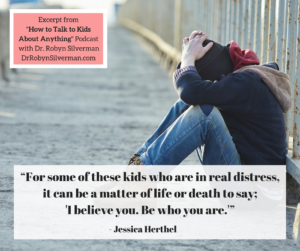 lives.
lives. - We can’t change these children. They are who they are. Everyday that we try to force them to be someone who they are not- we increase their risk for mental health issues and suicide.
- Many people try to “other” transgender youth- not feeling that they belong in the gender in which they identify.
- Transgender people would prefer to be asked what pronoun you like to use and what name you like to be called than to be gossiped about in secret and once again reminded that they are different.
- Be loving, kind and honest even if you don’t understand.
- We need to teach our kids not to make snap decisions about someone simply by assessing what they look like.
- Talking about gender nonconformity does not lead to gender non-conformity. Gender nonconformity is not contagious.
- Pointing out that there is a great deal of gendered messaging in toy stores and clothing stores can be a great way to start conversation with children.
- The concerns that our family might not be accepted or our child might not be accepted only goes away when we band together as a village and say we are going to love our children no matter what. Only then, the teasing goes away.
- Hair can be a signal to the world and can be a big deal for kids- allow your children to grow it or cut it so that they can express themselves.
- For some of these kids, the gender dysphoria of being in a body that feels wrong to them, it’s so overwhelming that children do very drastic things to get rid of this body part that feels wrong to them. If you have older kids, you can find a doctor so that you can press “pause” on puberty so you can get some help before puberty occurs.
- Puberty blockers are reversible- they buy time to learn more about your child and allow your child learn more about what s/he really wants.
- We need to give some profound thought, as parents, about our preconceived notions about gender.
- We walk around with a huge universe of preconceptions about what a boy or girl should look like and act like and what it means to be a man in our society or a woman in our society. Our preconceptions make us feel good because it helps us categorize our world. We need to think about what it would mean to look at the world without those 2 boxes.
Notable Quotables:
- “We aren’t pushing something onto a child who isn’t ready, we are simply following a child’s lead.”
- “We must love our children no matter how they intuitively or innately want to express gender- we are not trying to shape them but rather, listen to them.”
- “For some of these kids who really are on a different place on the gender spectrum than we assume they are, it can feel, to those kids, like they are telling a lie everyday by going by a name or putting on an outfit or playing with a set of toys that feels completely unnatural to them.”
- “Love the child you’ve got even if it’s not the child you expected.”
- “It’s not that these children are rebelling or that they have some kind of sexual deviance, these are sometimes very young children, 3 or 4 years old, who just want to be given the freedom to be honest about who they are.”
- “It can come down to our own preconceptions as a parent; letting go of something you wanted for your child and what we thought was meant to be. But what is meant to be is really much bigger than us. We have to be able to give over some of the control that we want to have as parents to let our children tell us who they are.”
- “Sometimes, we in the suburbs live these very sheltered lives and when we think about homeless people, we think about adults, army veterans, or people with mental illness. But the reality is that there is a shocking number of teens who live on the streets, 40% of whom are LGBT identifying who were kicked out of their home because they identified as gay or transgender or gender non-binary.
- “40% of kids who live on the streets are LGBTQ and 40-50% of unsupported transgender kids will attempt to take their lives.”
- “As parents, as educators, as people in the community, if there was anything we could do to reduce a 1 out of 2 risk of death, you would do it. A teen suicide affects the whole community and it’s not like childhood cancer to make those risk numbers go down. This is so easy to fix. It really just requires us to open our hearts and minds a little bit to what these kids are trying to tell us.”
- “You can force a child, you can shame a child, you can require a child to act and dress a certain way but who they are isn’t being changed by that.”
- “We owe it to our kids to lead with love.”
- “I’m a big fan of being proactive and telling kids that there are a lot of different people in this world and that’s why this world is so interesting! You are going to meet people who are different and it’s important to be compassionate and loving no matter who they are.”
- “Let kids lead you and then, follow them. This can only lead to a child feeling more confident and more loved which I feel like is really the goal.”
- “For some of these kids who are in real distress, it can be a matter of life or death to say; “I believe you. Be who you are.”
- “There are a lot of different ways to express gender and there is nothing inherently bad about not being in one extreme or another or one box or another. It would allow you more freedom and it certainly allows your kids more freedom. And I believe that more freedom really equals well-being.”

